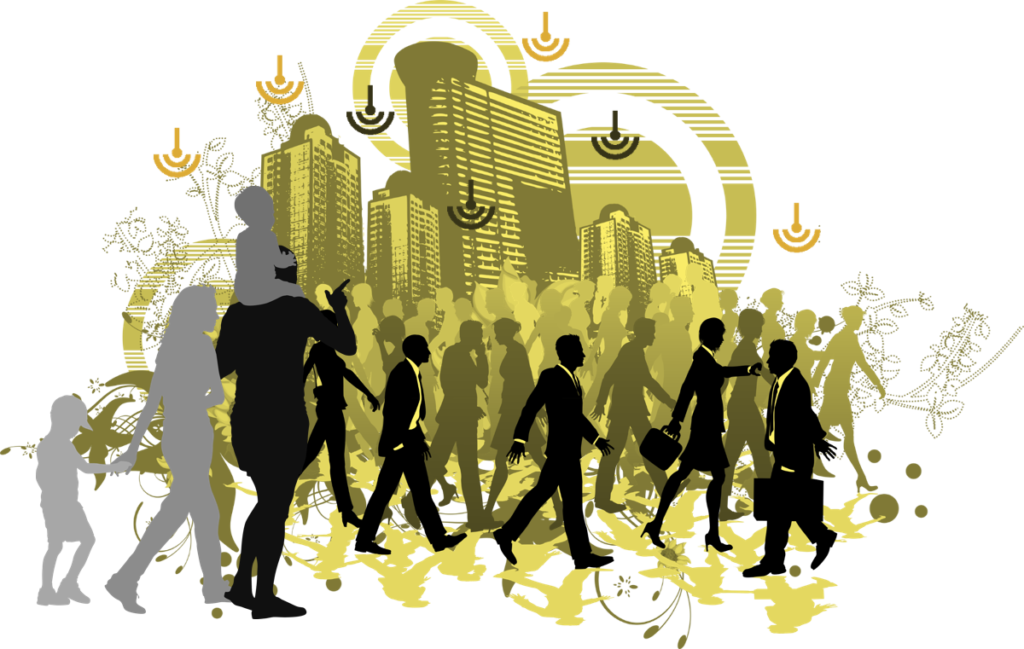People move to cities for many reasons, including the fact that resources can be used more efficiently and effectively when people live closer together. In the Digital Age, the desire to do even better (i.e., to become even more efficient and effective) is spurring the smart cities movement. Ted Smith (@Tedsmithphd), former chief innovation officer of the city of Louisville, KY, observes, “In this new century, the places we live and work and the transportation we use to move between them get smarter every day thanks to a host of innovations that have combined the Internet of Things (IoT) and the rising tide of expectations for safety, security, and convenience.”[1] He adds, “There is no place these forces have combined more confusingly than in the quest for the ‘smart city’.” There are three sides to making cities smart. The first side is the governmental side. Governments are generally in charge of public transportation, water, and sanitation. The second side is commercial sector, which often runs electrical grids and provides other services, like healthcare. The third side is the consumer/citizen side. Getting all three sides to work together is essential for making a city smart.
Getting all sides to work together
For good or ill, most smart city visions and proposals come from technology vendors. Smith explains, “No one is shocked that the technology industry is helping leaders see the future. This is how it has always been in enterprise technology, but now the enterprise is the city or the state or the country itself.” He goes on to note, the smart city vision is big. “This time,” he writes, “we are going beyond whether the city permit can be filed electronically or if the mayor is active on social media or whether crime data is machine-readable. This time, the entire infrastructure of the city is in play, and the truly big visions are often so expensive to contemplate that, in the US, we typically look to the federal government for seed money.”
On the government side, Phil Goldstein (@philgoldstein) suggests there are seven “core areas of city infrastructure that technology can transform to help bring smart cities to life.”[2] Those areas are:
1. Smart Parking. Goldstein explains, “The modern city is dominated in many ways by traffic, especially from cars. And, as cars roam city streets searching for open parking spots, they spew carbon dioxide and other tailpipe emissions, contributing to climate change.”
2. Smart Streetlights. “For cities looking to tap the Internet of Things, smart streetlight upgrades can give them a strong foundation. Cities can refurbish old streetlights with more energy-efficient LED bulbs, as well as wireless connectivity, motion sensors that activate lights when passersby are near and connected sensors that can alert the city when bulbs need to be changed. Those solutions can help make streets safer, all while saving governments a great deal of money on electricity costs.”
3. Smart Transportation. “Smart transportation systems,” Goldstein explains, “are a catchall that includes everything from driverless cars to smart traffic signals. Through sensors, analysis and communication among systems, intelligent transportation systems aim ‘to ease congestion, improve traffic management, minimize environmental impact and increase the benefits of transportation to commercial users and the public in general’.”
4. Smart Energy. “According to the nonprofit Smart Energy Consumer Collaborative, modernizing electric grids through smart grid enhancements ‘is an integral first step to enabling smart cities.’ Making renewables like rooftop solar power more realistic is ‘a game changer for sustainability,’ and increasing their use can enhance public health and improve the environment.” Smart grids also come into play; but, as noted earlier, electrical grids are often controlled by the commercial sector.
5. Smart Health. Goldstein notes, “Smart cities are often driven by increased connectivity.” Adie Tomer (@AdieTomer), a fellow at the Brookings Institution, and Rob Puentes (@rpuentes), President & CEO of EnoTrans, go even further. They bluntly state, “No industry or household in the world, will reach their future potential without access to broadband, it is the electricity of the 21st century.”[3] What, you may ask, does connectivity have to do with healthcare. Goldstein explains, “Those networks help enable sensors that collect and transmit data and, eventually, can improve city services. However, that connectivity can also help improve residents’ health.” He goes on to explain how many healthcare providers are investing in telehealth systems.
6. Smart Buildings. Goldstein reports, “According to Navigant Research, around of 30 percent global greenhouse gas emissions and 70 percent of energy consumption in major cities are attributable to buildings. Sensors in smart buildings can detect when there are people in a room so that temperature and lighting can be adjusted, saving money and sparing the environment, when rooms are not in use.”
7. A Smart Environment. Many analysts are hoping cities spearhead environmental causes. Goldstein writes, “As cities add more ‘green’ buildings that are energy efficient, they should also be thinking of how technology can improve the environment more broadly.” This technology, Goldstein explains, “applies to everything from sensors to detect water leaks, just-in-time waste collection and energy distribution. It can also apply to how cities are constructed.”
Getting the governmental side and the commercial side working together isn’t generally a problem — it’s a matter of money. Getting citizens involved is more difficult. Colin Wood explains, “Government agencies are increasingly adapting their services for mobile platforms, but recent industry research shows that just a third of citizens consider mobile devices their preferred mode of doing business with government, citing privacy and security as major barriers.”[4] Smart cities will only deserve that title when they are able to connect their citizens to the infrastructure and services being optimized by cognitive technologies.
Concluding thoughts
Because all stakeholders in cities need to be involved if cities are to become smart, a holistic approach is required. Smith explains, “There is a great phrase attributed to the venture capital industry: ‘Go big or go home.’ There is certainly some truth to the logic that a city is a big place with a lot going on and a single point solution is probably a missed opportunity to do something better if the whole system were on the table.” He believes the best place to start is with “painkillers.” He explains, “These are ‘must-haves’ and if your community is in pain, it will prioritize relief above all else. … Ultimately, we want our cities to be aware of problems, and we want them to predict and prevent the pain.” It’s up to government officials to identify pain points unique to their cities and to begin to improve the quality of life by fixing them first. All smart solutions, however, begin with connectivity. Connectivity is first step is helping make cities smarter.
Footnotes
[1] Ted Smith, “The problem with most ‘Smart City’ projects is they’re vitamins instead of painkillers,” TechRepublic, 31 October 2018.
[2] Phil Goldstein, “The 7 Things That Become ‘Smart’ in a Smart City,” StateTech, 7 November 2018.
[3] Adie Tomer and Rob Puentes, “Here’s the Right Way to Build the Futuristic Cities of Our Dreams,” Wired, 23 April 2014.
[4] Colin Wood, “Most people don’t want to access government services with their mobile devices,” StateScoop, 17 October 2018.




